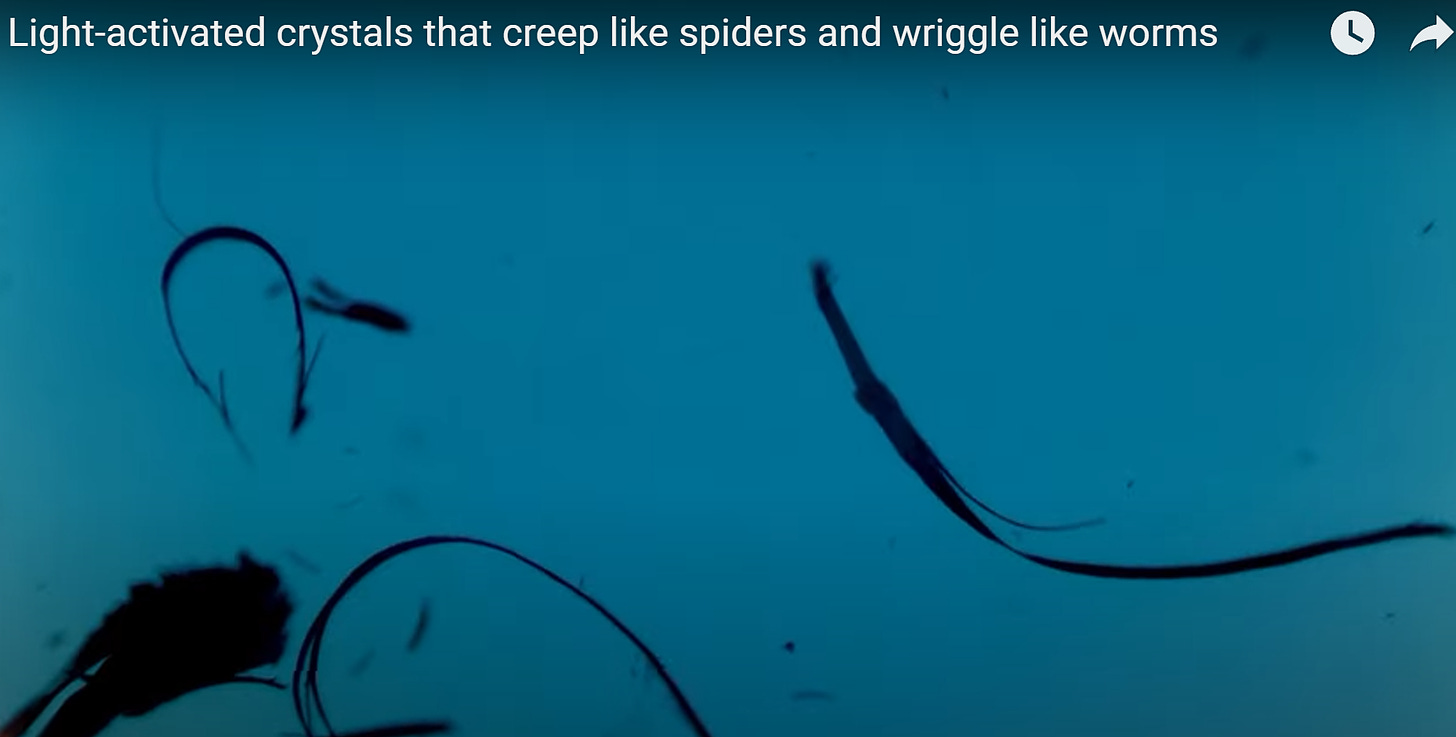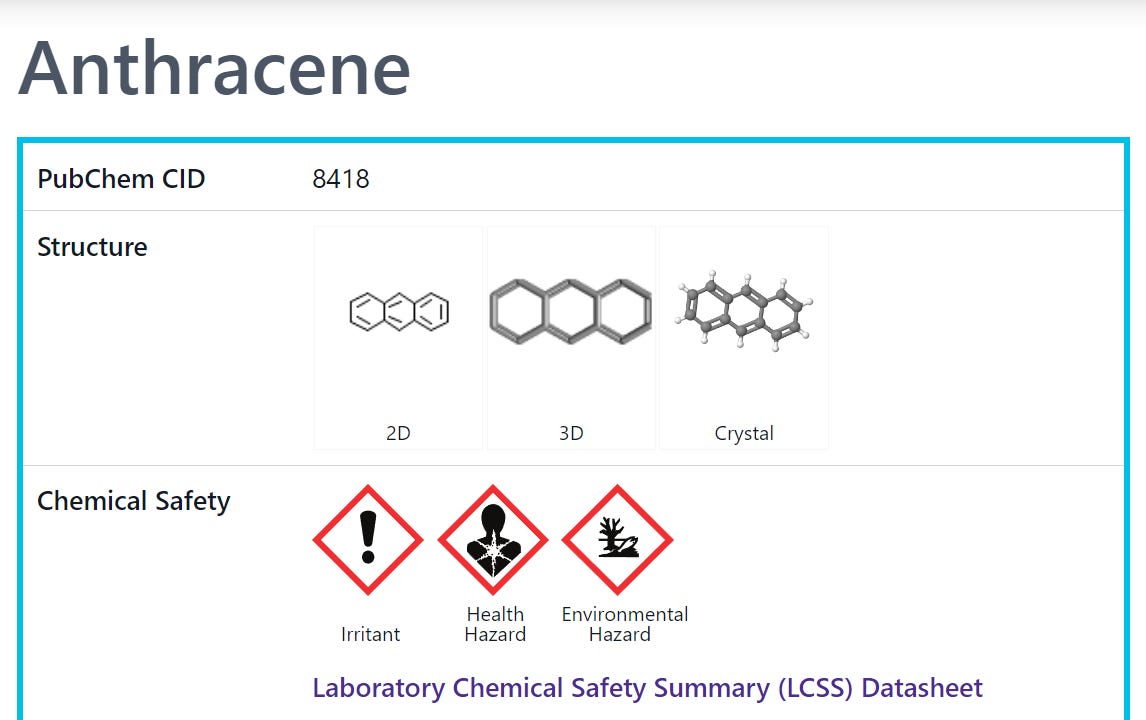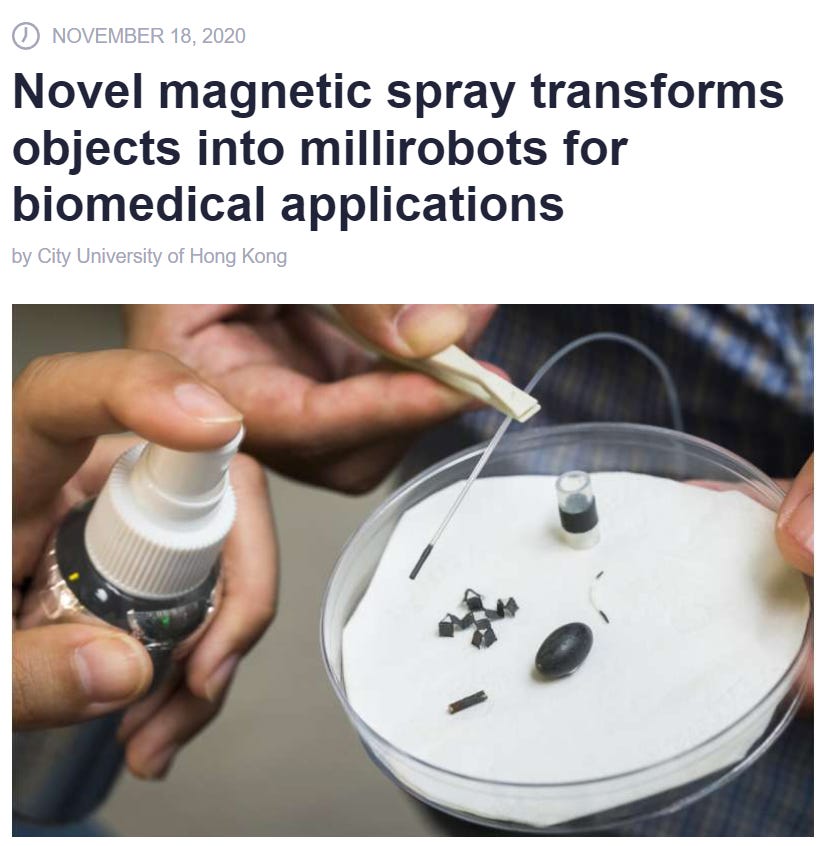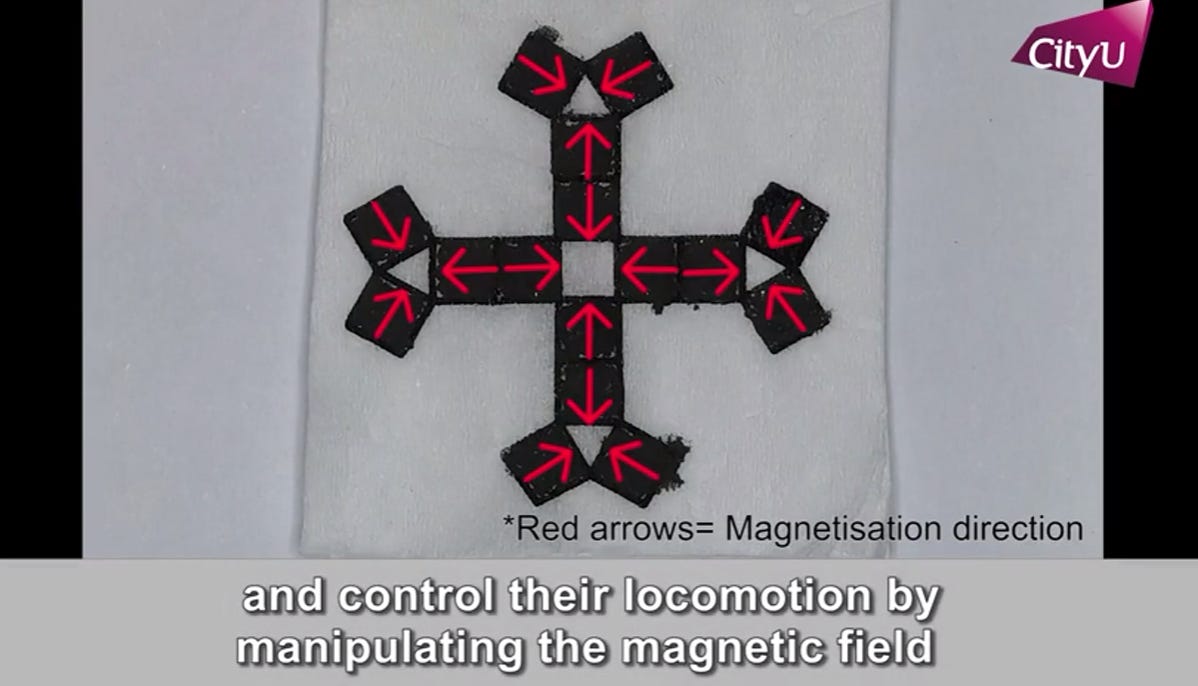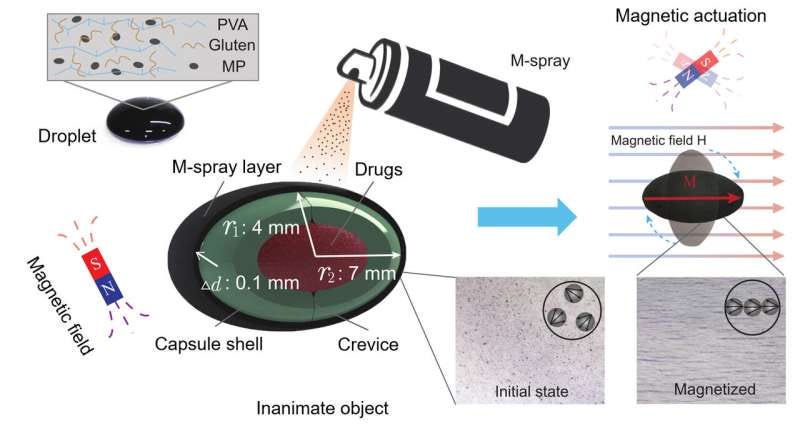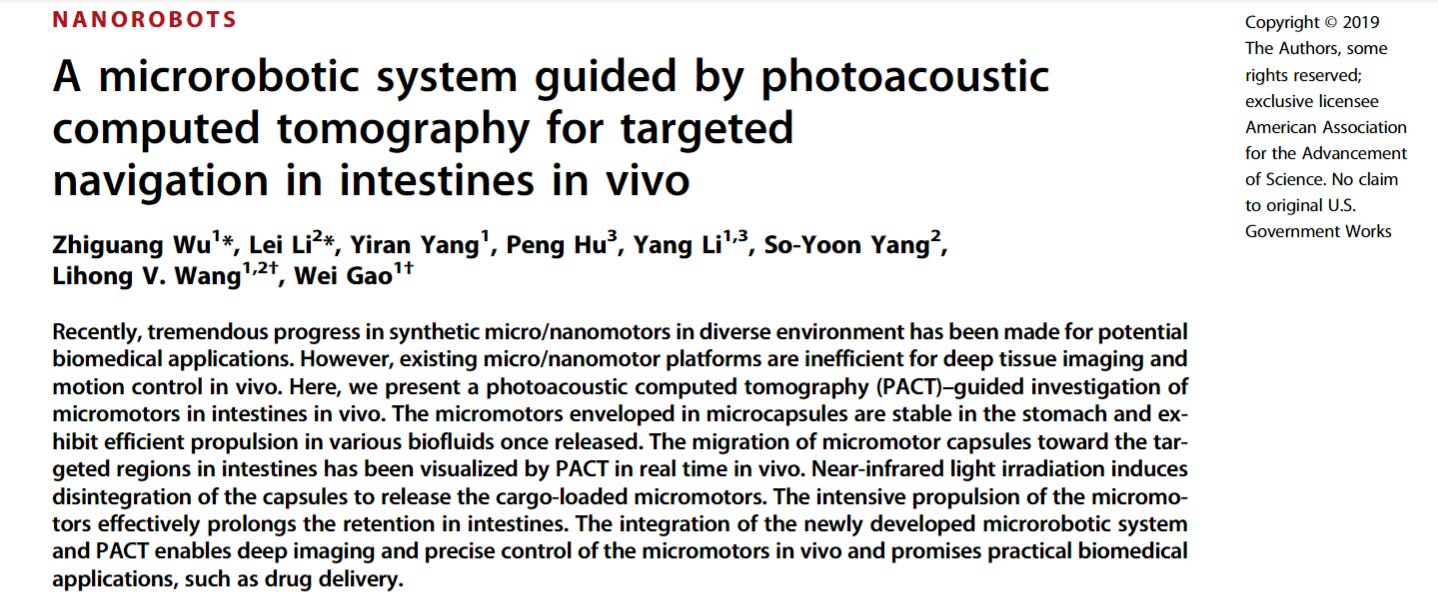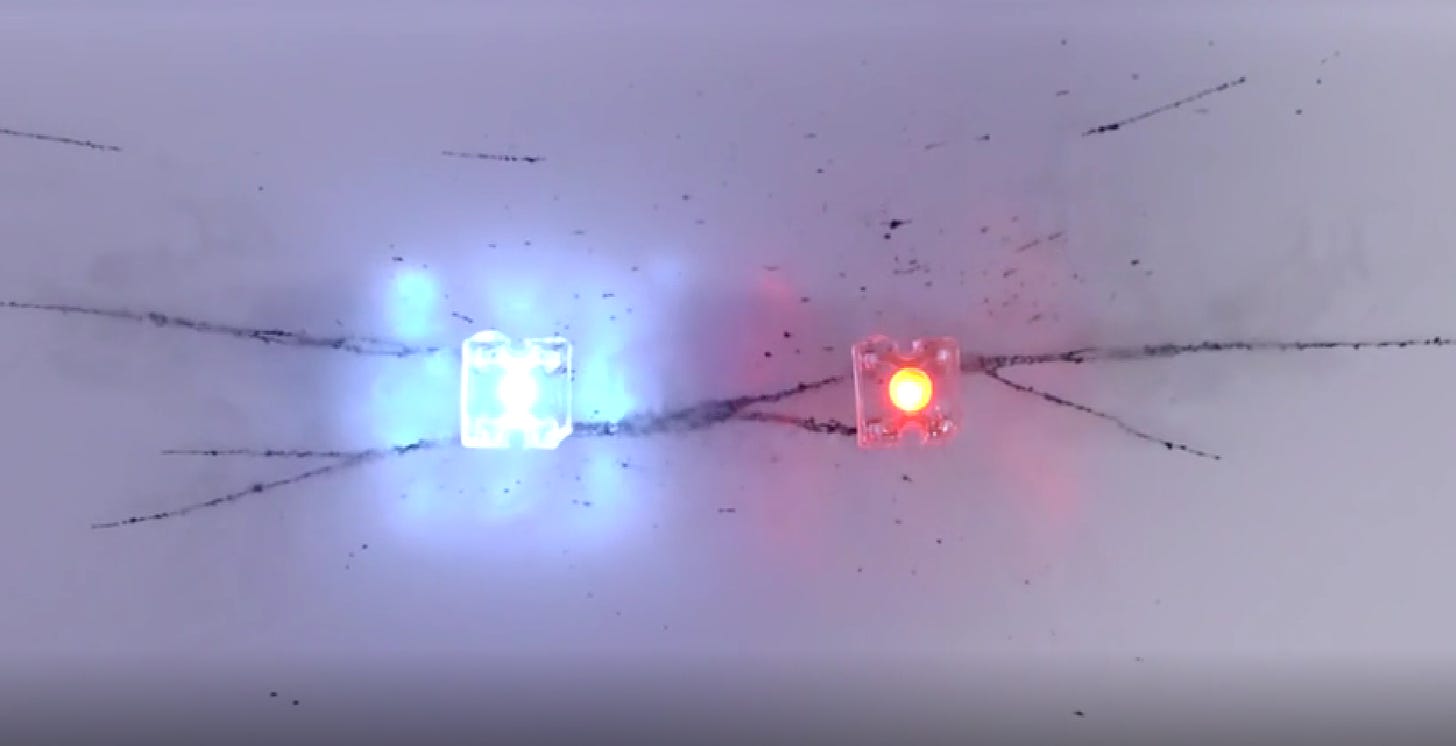THE TRUTH IS ALWAYS ON THE OTHER SIDE
Molecular crystal motors move like microbes when exposed to light
Don't forget.... everything is of course always so "great", “successful”, "biocompatible", absolutely "not harmful" and insanely "saftey" and "effective".... hallelujah!!!
https://phys.org/news/2024-03-molecular-crystal-motors-microbes-exposed.html
https://web.archive.org/web/20240320193028/https://phys.org/news/2024-03-molecular-crystal-motors-microbes-exposed.html
It looks like a spider and scurries like a spider, but it's actually a tiny motor made from crystallized molecules that move when exposed to light. Credit: Rabih O. Al-Kaysi
At first glance, Rabih O. Al-Kaysi's molecular motors look like the microscopic worms you'd see in a drop of pond water. But these wriggling ribbons are not alive; they're devices made from crystallized molecules that perform coordinated movements when exposed to light. With continued development, Al-Kaysi and colleagues say, their tiny machines could be used by physicians as drug-delivery robots or engineered into arrays that direct the flow of water around submarines.
The researchers will present their results today at the spring meeting of the American Chemical Society (ACS).
The team built their initial molecular crystal motor in 2021 with molecules that enabled photoisomerization—simply put, the individual molecules in the motor wave one of their chemical groups back and forth when exposed to light, and their collective motion results in visible movement of the motor itself.
"Our first motor was a microwire that bent and fluttered when I exposed it to a combination of UV and visible light," says Al-Kaysi. "It looked like a ribbon dancer. It looked alive."
The molecules in the team's first motor needed several wavelengths of light (UV and visible) to drive photoisomerization. However, Al-Kaysi and colleague Christopher Bardeen wanted to create molecular crystal motors that only needed a single wavelength of light to run. So, they synthesized a library of light-absorbent anthracene molecules capable of non-stop back-and-forth movement—i.e., continuous photoisomerization—with a single light source.
The researchers are in the process of characterizing the ‼️anthracene-based‼️
https://pubchem.ncbi.nlm.nih.gov/compound/Anthracene
molecules and using them as building blocks to create more molecular crystal motors. Their light-activated menagerie now includes long snake-like ropes and one very hairy spider that can bend, jump, twist and dance.
Al-Kaysi, an organic chemist at King Saud bin Abdulaziz University for Health Sciences and King Abdullah International Medical Research Center, has worked with Bardeen, a professor of chemistry at the University of California, Riverside, for more than two decades on photomechanical crystals.
These "smart" crystals convert energy they absorb from light into mechanical work and are typically characterized as thermally reversible or photochemically reversible. In other words, the crystals' initial movement in response to light stimulus is reversed with a second stimulus of heat or light, respectively. However, a third subset of these smart crystals is getting more attention from chemists like Al-Kaysi and Bardeen because of their ability to sustain continuous, oscillating movement when exposed to a single light source.
The photoreactive molecules in Al-Kaysi's library are the starting point for making molecular crystal motors. Each of the molecules contains three segments: an anthracene segment, a carbon double bond and a customizable "headgroup" on the other side of the carbon bond. The anthracene absorbs light and transmits the energy to the carbon double bond, which acts as the molecule's axle. Then the headgroup determines the molecule's crystal-packing structure, shape and behavior.
Once the anthracene molecules are synthesized, they are injected into a soapy solution where they pack together in a process called crystal engineering. These crystallized clumps are used as "seeds" and are placed into another soapy solution with more of the anthracene molecules where they self-assemble into larger shapes—typically rods and wires.
Some of these structures self-assemble into even more complex shapes that are visible with the naked eye. While the motor self-assembly is mostly random, the researchers are looking for ways to direct it by varying the temperature and soapiness of the liquid and by stirring the liquid at different speeds.
When illuminated in their soapy solution, the motors display intricate and continuous 3D motion. The researchers can tune a motor's movement by adjusting light intensity and wavelength. On a molecular level, the movement is driven by photoisomerization around the carbon double bond, the researchers know. However, they are still investigating how the molecules coordinate this behavior over the entire molecular crystal motor.
In demonstrations, the researchers found that the motors are remarkably durable, showing no signs of fatigue after hours of light exposure. And because they are crystal-based, they have an innate resistance to corrosion and electromagnetic interference and offer an "exceptional" weight-to-power ratio. According to the researchers, these qualities make the molecular crystal motors particularly suitable for biomedical applications, micromachines and microsatellites.
Al-Kaysi and Bardeen say that with the help of an "engineer's touch," their basic science discoveries have the potential to solve real-world problems, like light-activated molecular machines for drug delivery and arrays that direct the flow of water around a ship's hull.
And what else they came up with....
https://techxplore.com/news/2020-11-magnetic-millirobots-biomedical-applications.html
https://web.archive.org/web/20240320192029/https://techxplore.com/news/2020-11-magnetic-millirobots-biomedical-applications.html
With the M-spray, different tiny objects can be turned in to millirobots. Credit: City University of Hong Kong
Researchers in a joint research project led by a scientist from City University of Hong Kong (CityU) have developed an easy way to make millirobots, by coating objects with a glue-like, magnetic spray. Driven by the magnetic field, the coated objects can crawl, walk or roll on surfaces. As the magnetic coating is biocompatible and can be disintegrated into powders when needed, this technology demonstrates the potential for biomedical applications, including catheter navigation and drug delivery.
The research team is led by Dr. Shen Yajing, Associate Professor of the Department of Biomedical Engineering (BME) at CityU in collaboration with the Shenzhen Institutes of Advanced Technology (SIAT), Chinese Academy of Sciences (CAS). The research findings have been published in the scientific journal Science Robotics, titled "An agglutinate magnetic spray transforms inanimate objects into millirobots for biomedical applications."
Transforming objects into millirobots with a "magnetic coat"
Scientists have been developing millirobots or insect-scale robots that can adapt to different environments for exploration and biomedical applications.
Dr. Shen's research team came up with a simple approach to construct millirobots by coating objects with a composited glue-like magnetic spray, called M-spray. "Our idea is that by putting on this magnetic coat, we can turn any objects into a robot and control their locomotion. The M-spray we developed can stick on the targeted object and activate it when driven by a magnetic field," explained Dr. Shen.
Composed of polyvinyl alcohol (PVA), gluten and iron particles, M-spray can adhere to the rough, smooth surfaces of 1-D, 2-D or 3-D objects instantly, stably and firmly. The film it formed on the surface is just about 0.1 to 0.25 mm thick, which is thin enough to preserve the original size, form and structure of the objects.
After coating the object with M-spray, the researchers magnetized it with single or multiple magnetisation directions, which could control how the object moved by a magnetic field. Then they applied heat on the object until the coating was solidified.
In this way, when driven by a magnetic field, the objects can be transformed into millirobots with different locomotion modes, such as crawling, flipping, walking and rolling on various surfaces including glass, skin, wood and sand. The team demonstrated this feature by converting cotton thread (1-D), origami (2-D flat plane), polydimethylsiloxane film (2-D curved/soft surface) and plastic pipe (3-D round object) into soft reptile robot, multi-foot robot, walking robot and rolling robot, respectively.
On-demand reprogramming to change locomotion mode
The team can reprogramme the millirobot's locomotion mode on demand. Mr Yang Xiong, the co-first author of this paper, explained that conventionally, the robot's initial structure is usually fixed once it is constructed, hence constraining its versatility in motion. However, by wetting the solidified M-spray coating fully to make it adhesive like glue and then by applying a strong magnetic field, the distribution and alignment direction of the magnetic particles (easy magnetisation axis) of the M-spray coating can be changed.
Their experiments showed that the same millirobot could switch between different locomotion modes, such as from a faster 3-D caterpillar movement in a spacious environment to a slower 2-D concertina movement for passing through a narrow gap.
Navigating ability and disintegrable property
This reprogrammable actuation feature is also helpful for navigation towards targets. To explore the potential in biomedical applications, the team carried out experiments with a catheter, which is widely used for inserting into the body to treat disease or perform surgical procedures. They demonstrated that the M-spray coated catheter could perform sharp or smooth turns. And the impact of blood/liquid flow on the motion ability and stability on the M-spray coated catheter was limited.
By reprograming the M-spray coating of different sections of a cotton thread based on the delivery task and environment, they further showed that it could achieve a fast-steering and smoothly pass through an irregular, narrow structure. Dr. Shen pointed out that from the view of clinical application, this can prevent the unexpected plunging in the throat wall during insertion.
https://www.science.org/doi/epdf/10.1126/scirobotics.aax0613
https://web.archive.org/web/20240320191533/https://www.science.org/doi/epdf/10.1126/scirobotics.aax0613
And if you euthanize lab mice afterwards, you know with "certainty" that it's absolutely "effective" for humans.... yah, yah, yah
https://web.archive.org/web/20220810044033/https://sci-hub.se/10.1126/scirobotics.abf1390
Teslaphoresis | Self-Assembly of nanotubes using an electric field
https://rumble.com/v16ume7-teslaphoresis-self-assembly-of-nanotubes-using-an-electric-field.html
♥️♥️♥️




